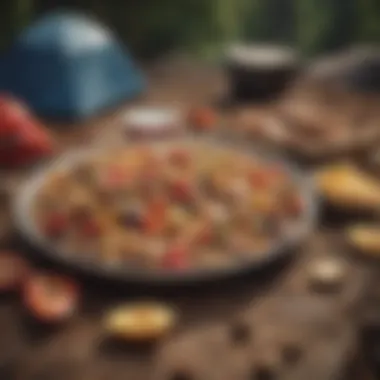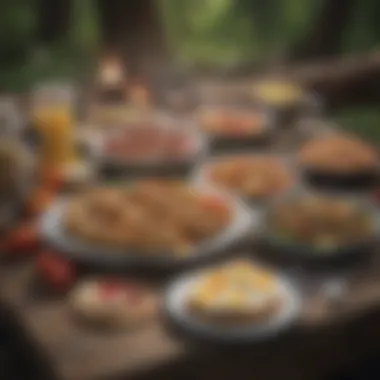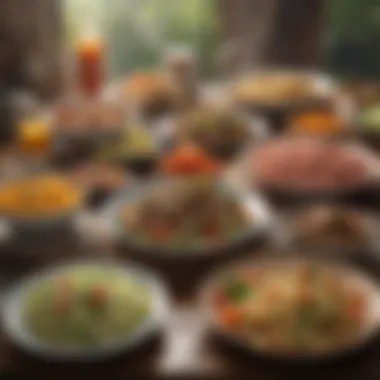No Cooking Camping Meals: A Practical Guide


Intro
Planning meals for a camping trip can feel overwhelming. It’s essential to ensure that the food is both convenient and nourishing, especially when cooking facilities are not available. This guide will explore no-cooking meal options that are practical for any camping excursion.
Recipe Overview
When considering meals for camping, it's crucial to select recipes that require minimal preparation. Many options exist which can make your dining experience enjoyable. Each recipe featured in this guide ensures ease of preparation while being nutritious and delicious.
Recipe Name and Description
One popular option is the Mediterranean Pita Wrap. This dish provides a satisfying blend of flavors with ingredients such as hummus, cucumbers, tomatoes, and olives wrapped in whole wheat pita bread. It is nutrient-rich and easy to assemble.
Cuisine Type
The Mediterranean cuisine is known for its health benefits and variety. The combination of fresh vegetables, legumes, and healthy fats makes it suitable for many dietary preferences.
Ingredients List
The following ingredients make up the Mediterranean Pita Wrap:
- Whole wheat pita bread: This serves as a wholesome base.
- Hummus: Use store-bought or homemade for flavor and creaminess.
- Cucumbers: Refreshing and hydrating.
- Tomatoes: Rich in vitamins, add color and taste.
- Feta cheese: Optional, for additional flavor and protein.
- Kalamata olives: For a briny, savory touch.
- Spinach or mixed greens: A good source of vitamins and fiber.
Detailed Ingredient Breakdown
Each ingredient adds distinct benefits:
- Whole wheat pita bread is high in fiber, helping with satiety.
- Hummus provides protein and healthy fats.
- Fresh vegetables enhance hydration and nutrient intake.
- Feta cheese, if included, is an excellent source of calcium and protein.
- Olives offer heart-healthy monounsaturated fats.
Substitutions for Dietary Needs
This recipe can be adjusted as needed to meet various dietary restrictions:
- Gluten-free: Substitute whole wheat pita with gluten-free wraps.
- Vegan: Omit feta cheese or use a plant-based alternative.
- Nut-free: Ensure that the hummus does not contain any nut products.
A diverse selection of no-cook meals allows for flexibility and creativity while camping. Having a variety of meal options can make your outdoor experience more enjoyable.
Epilogue
Selecting no-cook meals for camping is all about maximizing convenience and minimizing preparation time. Dishes like the Mediterranean Pita Wrap are just one example of how to make your meals enjoyable without the need for cooking. Focus on fresh ingredients and easy assembly, and you will eat well in nature.
Preamble to No Cooking Camping Meals
When preparing for an outdoor adventure, one critical aspect to consider is how to manage meals without cooking. This section explores the concept of no-cook camping meals, which can significantly simplify your experience in nature. As travelers, we seek convenience and efficiency. Therefore, understanding no-cook meals plays a crucial role in enhancing the camping experience.
Understanding No-Cook Meal Concepts
No-cook meals revolve around food options that do not require heat. These meals focus on convenience and ease. Typical choices include ready-to-eat foods, cold items, and simple combinations that can be made without a stove or cooking equipment. This approach emphasizes utilizing items that are practical for travel and storage.
The concept encourages a shift in mindset about meal preparation. For many, cooking while camping may seem essential, but embracing no-cook options opens up a new realm of culinary possibilities. This allows people to enjoy their surroundings without feeling tied to a cooking schedule. A good understanding of no-cook meal concepts transforms an ordinary camping trip into a unique dining experience.
The Benefits of No Cooking While Camping
Choosing not to cook while camping comes with several advantages. First, it saves time. There is no need to spend hours preparing meals, which means more time to enjoy activities such as hiking, fishing, or simply relaxing. Additionally, without the need for cooking tools, packing becomes lighter and more efficient. This aspect is particularly appealing for those who prefer minimalist camping.
Next, no-cook meals often highlight nutritional value. Many options, such as fruits, nuts, and whole grains, are nutrient-rich and provide sustained energy. By focusing on fresh produce and ready-to-eat items, campers can enjoy wholesome food choices.
Lastly, no-cooking camping meals offer variety. The range of foods available encourages creativity. Campers can combine different ingredients to create flavorful, satisfying meals without the limitations of traditional cooking. This flexibility allows for personal preferences and dietary needs to be easily accommodated.
Exploring no-cook meals can enhance your camping experience by providing convenience, time savings, and diverse food options.
In summary, the concept of no-cook camping meals is essential for simplifying meal management during outdoor trips. Understanding this approach leads to various benefits, including time efficiency, enhanced nutrition, and creative meal options, making outdoor adventures even more enjoyable.


Essential Meal Categories
The importance of essential meal categories in camping cannot be overstated. Meal categories help in organizing food selections while providing a balanced dietary intake. Having distinct categories like snacks, breakfasts, lunches, and dinners simplifies planning. Each meal category serves unique nutritional needs, making it easier to focus on energy, sustenance, and overall enjoyment of the outdoor experience.
Snacks and Light Bites
Trail Mix Variations
Trail mix variations are a versatile choice for camping trips. They combine nuts, dried fruits, seeds, and sometimes chocolate or granola. This mixture offers a balance of protein, carbohydrates, and healthy fats. It is easy to pack and can provide quick energy during hikes or other activities.
Key characteristics of trail mix include its adaptability. You can customize it based on preferences or dietary restrictions. Whether someone prefers a sweet or savory option, there’s always a mixture to fit their taste. The unique feature of trail mix is its portability; it requires no refrigeration and can last for weeks. That makes it a popular snack for campers. However, while packed with nutrients, portion control is necessary to prevent excessive calorie intake.
Nut Butters and Crackers
Nut butters and crackers are another excellent no-cook option. This combination is satisfying and provides lasting energy. Nut butters like almond or peanut butter are rich in proteins and healthy fats. Crackers offer carbohydrates, making this pairing balanced.
The key characteristic of nut butters is their protein content, promoting satiety. They are also easy to spread, allowing for quick meal prep. A unique feature is that they come in various flavors, catering to different appetites. While this option is nutritious, some may find nut butters too caloric. Such considerations are worth noting for those monitoring their intake.
Breakfast Ideas
Overnight Oats
Overnight oats represent a practical choice for breakfast. They require minimal preparation and provide a hearty start to the day. Made by soaking oats in liquid overnight, they can include fruits, nuts, or sweeteners. This choice is often appealing due to its fiber content and satisfaction.
Overnight oats' key characteristic is their flexibility; one can modify ingredients based on personal preference or dietary needs. The unique feature is their ability to be prepared in advance, saving time in the morning. However, if not stored properly, they may spoil quickly, especially in warm conditions.
Instant Breakfast Options
Instant breakfast options, like oatmeal packets or smoothie powders, are convenient for those without prep time. These ready-to-eat solutions can hydrate in just a few moments. Moreover, they often come fortified with vitamins and minerals to enhance nutritional value.
Their key characteristic is the speed of preparation, which is especially useful in a camping context. Instant options can often be enjoyed warm or cold, suiting varying personal preferences. However, some might find the taste less appealing compared to fresh food, which could be a downside for discerning palates.
Lunch Selections
Wraps and Sandwiches
Wraps and sandwiches are simple yet satisfying lunch choices. They are easy to assemble, making them ideal for campers. Wraps can include various fillings, from deli meats to cheese and veggies. Sandwiches also allow for creativity while being transportable.
The key characteristic of these meals is their adaptability. You can make them with different breads or fillings, catering to tastes. The unique feature is their no-mess consumption, beneficial in outdoor settings. However, keeping them fresh could become an issue without proper storage.
Salads in a Jar
Salads in a jar are a refreshing and healthy meal selection. Layering ingredients in a jar keeps them crisp and appetizing until they are ready to eat. This method allows for creative combinations of veggies, grains, and proteins.
Their key characteristic is portability and the ability to prepare them in advance. Salads in jars can be made in various ways, accommodating different dietary requirements. A unique advantage is how they stay fresh, though careful layering is crucial to avoid sogginess.
No-Cook Dinners
Cold Pasta Salads
Cold pasta salads are filling and refreshing for dinner. These salads can be prepared ahead and require no cooking on-site. They can incorporate an array of vegetables, proteins, and dressings, making them versatile.
Their key characteristic is their versatility. Cold pasta salads can suit various dietary preferences easily. Unique features include being served chilled, which can be very refreshing. However, balance is important; too many rich dressings can add unwanted calories.
Chilled Soups
Chilled soups are an innovative dinner idea. These soups can be made using canned ingredients or premade versions. They offer hydration, which is essential while camping.
The key characteristic of chilled soups is their lightness and refreshment. They can provide a cooling effect on warm days, which is a significant benefit. However, good storage is essential to avoid spoilage, limiting their practicality in certain camping conditions.
Meal Preparation and Storage


Meal preparation and storage are essential components of enjoying no-cook camping meals. The right approach to these aspects can drastically enhance convenience and ensure that meals remain safe and fresh during your adventure. By selecting suitable ingredients and utilizing efficient storage solutions, you can avoid the hassles of cooking while still enjoying nutritious and satisfying meals. The focus here is on strategies that not only simplify your camping experience but also keep your food safe and enjoyable.
Selecting the Right Ingredients
Selecting the right ingredients is vital for creating easy and satisfying no-cook meals while camping. Ingredients should be durable, convenient, and capable of maintaining their freshness without the need for refrigeration or cooking.
Durable Breads and Crackers
Durable breads and crackers are ideal choices for no-cook meals. Their key characteristic is their long shelf life and resistance to spoilage. This feature allows them to endure varied camping conditions without compromising their quality. Moreover, they are lightweight and easy to pack, making them a popular option among campers.
One unique aspect of durable breads is that many varieties are suitable for sandwiches, wraps, or as a base for toppings. Crackers can serve as a crunchy side to dips or spreads. However, while they are beneficial in terms of convenience, they may contain preservatives that some individuals prefer to avoid.
Non-Perishable Proteins
Non-perishable proteins are crucial in building well-rounded no-cook meals. These may include canned beans, vacuum-sealed meats, or plant-based protein sources. The primary advantage of these proteins is their ability to provide essential nutrients without the need for refrigeration.
A significant feature of non-perishable proteins is their versatility; they can be added to a variety of meals, from salads to wraps. They offer a convenient way to ensure your meals remain filling and nutritious. However, some may find the texture or flavor of specific non-perishable proteins less appealing than their fresh counterparts, which is a consideration to keep in mind.
Optimal Storage Solutions
Efficient storage solutions are just as important as ingredient selection. Proper storage keeps your food fresh, prevents contamination, and makes meal prep easier.
Coolers and Insulated Bags
Coolers and insulated bags are pivotal for maintaining food temperature and freshness during camping. Their main advantage lies in their ability to keep perishables cool during the trip. An insulated bag helps maintain the inner temperature, so items like yogurt or cheese can be enjoyed well into the camping experience.
The unique feature of a cooler is its robust insulation, designed to keep ice for longer periods. This can be beneficial for those who plan to camp for several days. However, one disadvantage is that coolers can be bulky, requiring additional effort to transport.
Sealed Containers
Sealed containers play a critical role in food storage. Available in various sizes and materials, they help keep food fresh and prevent leaks. A notable characteristic of sealed containers is their hermetic sealing system, which blocks air and moisture, contributing to longer food shelf life.
These containers are ideal for meal prep, allowing you to combine ingredients ahead of time without worrying about spoilage. However, there is a disadvantage of sometimes lacking durability, leading to breakage during transport.
Planning Snacks for Energy
Planning snacks for energy is crucial for anyone active in the outdoors. Proper snacks can boost energy levels while hiking or engaging in other activities. Snacks should be easy to pack, nutritious, and flavorful, offering sustenance as you explore.
Whole food snacks such as nuts, seeds, and dried fruits are excellent choices, providing protein and good fats. Granola bars and energy bites can also serve as delightful, easy-to-carry options, sustaining you throughout your adventure. This thoughtful planning ensures that you maintain energy levels while maximizing your experience in nature.
Nutrition Considerations
When planning no-cook meals for camping, nutrition plays a crucial role. It's not just about convenience; it's also essential to maintain adequate energy levels while enjoying the outdoors. A well-balanced diet contributes to overall health, helps sustain physical activity, and keeps your mood in check during your trip. With so many meal options available, being mindful of nutritional intake can significantly enhance the camping experience.
Maintaining Balanced Nutrition
To ensure your meals are nutritionally adequate, consider including a variety of food groups. This includes proteins, carbohydrates, fats, vitamins, and minerals. A balanced meal will provide sustained energy for hiking, exploring, or simply enjoying nature.
- Proteins: Pack items like canned tuna, jerky, or nut butters. They help with muscle repair and provide lasting energy.
- Grains: Options like whole grain wraps or directly oats supply carbohydrates, key for fueling outdoor activities.
- Fruits and Vegetables: Fresh fruits, like apples or cucumbers, are hydrating and rich in vitamins. Meanwhile, dried fruits can be a compact snack with a long shelf life.
- Fats: Healthy fats from nuts, seeds, or avocado can help with satiety and energy needs.
It's essential to balance these food groups while being mindful of serving sizes. For instance, having too many carbohydrates without sufficient protein can lead to crashes in energy. Planning meals with a mix ensures you receive the nutrients you need for an enjoyable trip.
Hydration While Camping
Hydration is just as critical as nutrition when camping. Outdoor activity can lead to increased fluid loss, especially in warm weather or high altitudes. Ensuring adequate hydration helps maintain energy levels and cognitive function. Carrying water should be a priority.
- Packing Water: Insulated water bottles can keep beverages cool, making it pleasant to drink throughout the day.
- Water Purification: For longer trips, consider portable water filters or purification tablets. These allow you to refill your supplies safely from natural sources.
- Electrolyte Drinks: If engaging in strenuous activities, consider electrolyte tablets to replenish essential minerals lost through sweat.
Important Note: Always drink water regularly, even if you do not feel thirsty. Dehydration can sneak up on you, especially in dry outdoor environments.
In summary, focusing on balanced nutrition and hydration can elevate your camping experience, making it not only enjoyable but also healthy.


Gear Recommendations
When planning for no-cook meals while camping, selecting the right gear plays a crucial role in ensuring a successful and enjoyable outdoor experience. Proper gear not only enhances convenience but also contributes to the overall efficiency of meal preparation and consumption. Understanding the types of equipment that support your meal choices can make your camping trip smoother, allowing you to focus on enjoying nature rather than worrying about logistics.
Essential Camping Tools
Multi-Utility Knives
Multi-utility knives are often considered a must-have in camping gear. These tools are designed to offer various functions in a compact form. The key characteristic of multi-utility knives is their versatility; they often include features such as blades, screwdrivers, scissors, and can openers, making them incredibly beneficial for anyone embarking on a camping trip.
One unique feature of many models is their durability. Made from high-quality materials, they can handle a range of tasks, from prepping snack items to opening food containers. This adds an advantage for those relying on no-cook meals, as it simplifies meal preparation considerably. However, one might argue that their compact size could make them challenging to use for larger tasks, like slicing through thicker materials. Nonetheless, their size makes them easy to carry, which makes them a popular choice for campers.
Portable Storage Bags
Portable storage bags play an essential role in keeping prepared meals and ingredients fresh during camping trips. These bags are typically lightweight and designed with insulation properties. The key characteristic of portable storage bags is their ability to provide convenience. They can easily fit into backpacks and help in organizing different types of food.
A unique feature of these bags is their resealability, which prevents spills and maintains food quality over time. This is especially important for no-cook meals, where food items like salads or sandwiches need to stay fresh longer. On the downside, if not properly sealed, some bags may not prevent leakage, leading to messy backpacks. Nevertheless, their advantages in terms of convenience and food preservation make them indispensable for camping.
Portable Eating Utensils
Having portable eating utensils is another vital aspect of a camping trip focused on no-cook meals. These tools typically include forks, spoons, and knives, often made from lightweight materials like plastic or titanium. The main benefit of portable utensils is their ease of transport, allowing campers to enjoy their meals without the burden of heavy dinnerware.
Portable utensils often come in reusable sets, which contribute to eco-friendly camping practices. This is an important consideration for those committed to reducing waste. While they are lightweight and convenient, it's essential to ensure they are sturdy enough for robust meals. The pressure applied during eating can sometimes lead to breakage in lower-quality sets.
Whether you are packing a multi-utility knife or a set of portable storage bags, each item can contribute greatly to a seamless camping experience. By investing in quality gear, you not only prepare more efficiently but also enjoy greater flexibility in meal choices.
Creative No-Cook Meal Ideas
Creative no-cook meal ideas play a crucial role in enhancing the outdoor dining experience. Camping, while intended to immerse oneself in nature, can sometimes pose challenges regarding food preparation. These ideas not only simplify meal planning but also encourage a sense of adventure in flavor and texture. By thinking outside the box, campers can enjoy nutritious and satisfying meals without the hassle of cooking. With an array of options available, no-cook meals can be both delightful and inventive.
Combining Flavors and Textures
Combining flavors and textures is essential when creating no-cook meals. A well-balanced meal invites diverse sensations that can elevate the dining experience. For instance, combining crunchy vegetables with smooth spreads can add depth and interest.
Some potential combinations include:
- Hummus with cucumber slices: The creamy texture of hummus pairs well with the crispness of fresh cucumbers.
- Cheese with crunchy crackers: Different cheese varieties can bring a range of flavors, complemented by hearty crackers.
- Fruits with nuts: Mixing sweet fruits like apples or berries with savory nuts creates a satisfying balance.
These combinations help not only to please the palate but also to enhance the visual appeal of the meal. A colorful layout can be more inviting and enjoyable. The right combinations can also facilitate better nutritional intake by ensuring vitamins, fibers, and proteins are included.
Adaptations for Dietary Restrictions
Dietary restrictions need not be a barrier when it comes to no-cook meals. With careful planning, meals can cater to various preferences and requirements. Whether considering vegetarian, vegan, gluten-free, or other diets, many options are available.
- Vegetarian options: Use legumes, such as chickpeas or lentils, mixed with fresh vegetables to create a filling salad.
- Vegan meals: Avocado toast made with whole grain bread, topped with sliced tomatoes and seeds, provides nutrition without animal products.
- Gluten-free snacks: Rice cakes or corn tortillas can serve as a base for various toppings, ensuring those with gluten sensitivities can enjoy meals too.
When planning these meals, always read ingredient labels for hidden allergens. This thoughtful approach ensures everyone can savor the camping experience without limitation.
Remember, flexibility is vital in the outdoors. Adapting your meals to satisfy everyone's dietary needs can create a spirit of inclusion and enjoyment among campers.
Ending and Final Thoughts
Engaging in the art of no-cook meals while camping allows individuals to embrace the outdoors without the complexity of traditional cooking. This approach serves various benefits, making it an appealing option for all types of outdoor enthusiasts. The ease of preparation, combined with the need to keep nourishment simple, embodies the spirit of camping. Individuals can focus on the beauty around them rather than stress about meal logistics.
Recap of No Cook Benefits
The main advantages of no-cook camping meals extend beyond just convenience.
- Time-Saving: Without the need to cook, more time is freed for exploring and enjoying nature.
- Reduced Equipment: Many campers opt for minimalist packing, and avoiding cooking gear helps lighten the load.
- Simplicity: By using ready-to-eat ingredients, meal planning becomes straightforward.
- Versatility: Meal options can cater to a variety of dietary preferences, ensuring everyone can find something that suits their needs.
- Safety: Eating without cooking reduces the likelihood of foodborne illness from improper food handling.
Overall, these benefits offer a compelling case for the adoption of no-cook meals on camping trips, meeting the needs of modern adventurers.
Encouragement for Outdoor Cooking Without Cooking
For those hesitant about foregoing traditional cooking methods, it's worth considering. Embracing no-cook meals can lead to a more fulfilling outdoor experience. Here are some motivational points:
- Focus on Experience: Shift attention from meal preparation to storytelling, star gazing, or engaging with fellow campers.
- Improve Creativity: Experimenting with diverse combinations of ingredients can inspire new meal ideas.
- Enjoy the Journey: Discovering new snacks and meals becomes part of the camping adventure itself.















